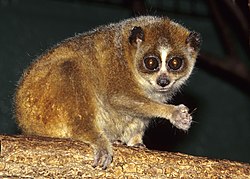Behavior and ecology
Lorisids are nocturnal and arboreal. Unlike the closely related galagos, lorisids never jump. Some have slow deliberate movements, whilst others can move with some speed across branches. It was previously thought that all lorisids moved slowly, but investigations using red light proved this to be wrong. Nonetheless, even the faster species freeze or move slowly if they hear or see any potential predator. This habit of remaining motionless whilst in danger is successful only because of the leafy environment of their jungle home, which helps to conceal their true position. [4] With their strong hands they clasp at the branches and cannot be removed without significant force. Most lorisids are solitary or live in small family groups.
Slow lorises from southeast Asia produce a secretion from their brachial gland (a scent gland on the upper arm, between the axilla and elbow), that is licked and mixed with their saliva to form a toxin which may be used for defense. The slender lorises from Sri Lanka and South India also possess these brachial glands, but it is uncertain whether they also synthesize the toxin. The potto (Perodicticus potto) is thought to lack brachial glands, though it produces similar toxic excretions with its anal glands.
Lorisids have a gestation period of four to six months and give birth to two young. These often clasp themselves to the belly of the mother or wait in nests, while the mother goes to search for food. After three to nine months - depending on the species - they are weaned and are fully mature within 10 to 18 months. The life expectancy of lorises can be to up to 20 years.
Lorisids consume insects, bird eggs and small vertebrates as well as fruits and gums. [6] [7] [8] [9]
This page is based on this
Wikipedia article Text is available under the
CC BY-SA 4.0 license; additional terms may apply.
Images, videos and audio are available under their respective licenses.


